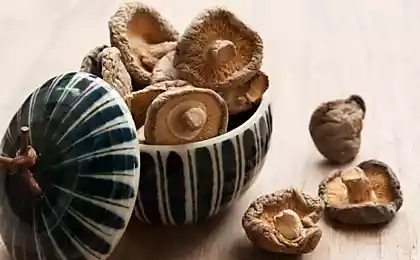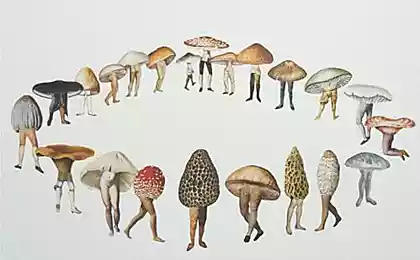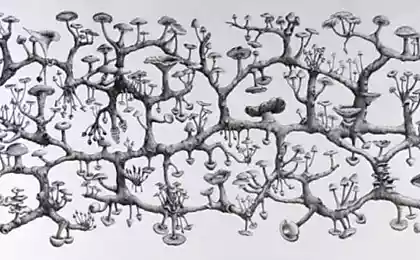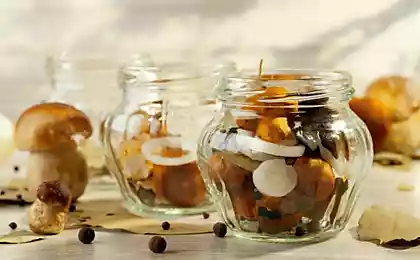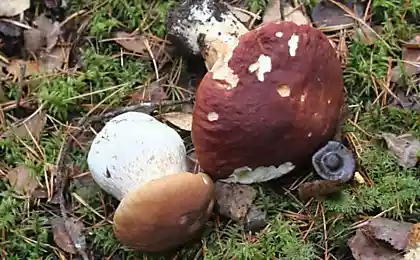453
The mushrooms had settled on the plants through bacterial genes
Horizontal gene transfer from bacteria to fungi on plant roots occurred at least fifteen times.
Now few people doubt the enormous role played by horizontal gene transfer in the evolution of bacteria and archaea – their genes can easily leave one cell and move to another without any cell division. Gene transfer in bacteria and archaea is carried out in different ways, they play a role of viruses and viral elements, and the ability of the bacteria to just take DNA from the external environment, and other mechanisms. It is clear that a new gen means new possibilities, including evolutionary. The bacterium can use it to explore previously inaccessible to her niche, though, for this she will need to keep the gene to yourself.

As for the eukaryotes, which include animals, plants, fungi, they have considered horizontal gene transfer is very, very weak, if at all. Eukaryotes share genes almost exclusively vertical, i.e. from parents to descendants, and raw materials for the evolution of their genome to deliver a variety of genetic mutations, including doubling (duplication) of entire genes. Examples of the exchange of genes between different species of animals, plants, or between them and the bacteria are very few.
However, as suggested by researchers from Lyon University, horizontal gene transfer in eukaryotes it happens more often than one might think – at least if you keep in mind the exchange of genes between eukaryotes and bacteria. Daniel Mueller (Daniel Muller), along with colleagues, studied soil bacteria living near the roots of plants. These bacteria have the gene acdS, which promotes growth of the root system. And so, when their genomes compared with the genomes of several eukaryotic organisms, it was found that the gene acdS have 61 species of fungi. (Plus four species of parasitic oomycetes, which had also belonged to the mushrooms.)
As write the authors in the Proceedings of the Royal Society B, most likely a bacterial gene got to the eukaryotes by horizontal transfer, and this transfer took place not just once but as many as fifteen, and donors of the gene were three types of bacteria. Once in a new host, acdS continued to perform the same function, that is facilitates interaction between the plant and the gene. Mushrooms with acdS in the genome was easier to colonize the roots, in other words, to master a new environment.
Even if we take into consideration that mushrooms are simpler same plant, such a high frequency of gene transfer is unusual. Is it possible that the bacteria still continue to some extent, to shape eukaryotic genomes? However, some biologists believe that the likelihood of gene transfer from bacteria to eukaryotes is somewhat exaggerated, simply because we are not always able to exactly recover we are interested in evolutionary trees, and therefore are not always able to understand exactly where and when it happened the transfer.
On the other hand, is not very clear, as in this case, the gene can jump from bacteria to fungi. He made his journey alone, while normally the horizontal shift is occurring with a group of genes. In addition, the question arises about the molecular mechanisms of "jump" acdS, as no usual DNA sequences, which carry out such operations, there have not found. But bacteria and mushrooms is still the same radical ecological niche, and their close neighborhood speaks in favor of a possible horizontal gene transfer.
Source: nkj.ru
Now few people doubt the enormous role played by horizontal gene transfer in the evolution of bacteria and archaea – their genes can easily leave one cell and move to another without any cell division. Gene transfer in bacteria and archaea is carried out in different ways, they play a role of viruses and viral elements, and the ability of the bacteria to just take DNA from the external environment, and other mechanisms. It is clear that a new gen means new possibilities, including evolutionary. The bacterium can use it to explore previously inaccessible to her niche, though, for this she will need to keep the gene to yourself.

As for the eukaryotes, which include animals, plants, fungi, they have considered horizontal gene transfer is very, very weak, if at all. Eukaryotes share genes almost exclusively vertical, i.e. from parents to descendants, and raw materials for the evolution of their genome to deliver a variety of genetic mutations, including doubling (duplication) of entire genes. Examples of the exchange of genes between different species of animals, plants, or between them and the bacteria are very few.
However, as suggested by researchers from Lyon University, horizontal gene transfer in eukaryotes it happens more often than one might think – at least if you keep in mind the exchange of genes between eukaryotes and bacteria. Daniel Mueller (Daniel Muller), along with colleagues, studied soil bacteria living near the roots of plants. These bacteria have the gene acdS, which promotes growth of the root system. And so, when their genomes compared with the genomes of several eukaryotic organisms, it was found that the gene acdS have 61 species of fungi. (Plus four species of parasitic oomycetes, which had also belonged to the mushrooms.)
As write the authors in the Proceedings of the Royal Society B, most likely a bacterial gene got to the eukaryotes by horizontal transfer, and this transfer took place not just once but as many as fifteen, and donors of the gene were three types of bacteria. Once in a new host, acdS continued to perform the same function, that is facilitates interaction between the plant and the gene. Mushrooms with acdS in the genome was easier to colonize the roots, in other words, to master a new environment.
Even if we take into consideration that mushrooms are simpler same plant, such a high frequency of gene transfer is unusual. Is it possible that the bacteria still continue to some extent, to shape eukaryotic genomes? However, some biologists believe that the likelihood of gene transfer from bacteria to eukaryotes is somewhat exaggerated, simply because we are not always able to exactly recover we are interested in evolutionary trees, and therefore are not always able to understand exactly where and when it happened the transfer.
On the other hand, is not very clear, as in this case, the gene can jump from bacteria to fungi. He made his journey alone, while normally the horizontal shift is occurring with a group of genes. In addition, the question arises about the molecular mechanisms of "jump" acdS, as no usual DNA sequences, which carry out such operations, there have not found. But bacteria and mushrooms is still the same radical ecological niche, and their close neighborhood speaks in favor of a possible horizontal gene transfer.
Source: nkj.ru

